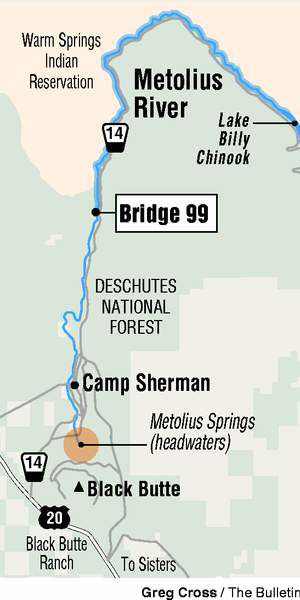Farther downstream…
Published 4:00 am Thursday, January 21, 2010

- Farther downstream...
Mention the Metolius River, and you see a sparkle in the eyes of fly anglers as they conjure images of a mystical river churning through remote, wild and rugged country unspoiled by human development.
Perhaps even more remote, wild, and rugged is the Metolius River downstream of Bridge 99. Highlighted by roaring rapids, and by thick brush and giant ponderosa pine trees along its banks, this stretch of the Metolius is home to big bull trout, redband trout and whitefish.
Relatively few anglers venture that far downstream, so it is possible to target fish that have experienced less pressure from fishermen than on more-popular sections of the river closer to U.S. Highway 20.
The Metolius below Bridge 99, about 15 miles north of Black Butte Ranch, is restricted to artificial flies and lures, while upstream of the bridge is restricted to fly angling only. Catch-and-release is the only fishing permitted on the entire river.
“It’s kind of known as a fly-fishing-only river, and that section is no longer fly-fishing-only,” Jeff Perrin, owner of the Fly Fisher’s Place in Sisters, said this week. “I think people shun it because of that. But the reality is it’s a wonderful place to fly-fish. It is a little bit farther away, and the perception is it’s really big water.”
That perception is rooted in some reality.
I made the trip to the area Monday on a cloudy, drizzly morning.
At Bridge 99, the paved Forest Road 14 turns into the gravel Forest Route 1499, which is restricted to hikers and bikers.
The road — at least for motorized vehicles — literally ends at Bridge 99.
I hiked the east bank of the river. After a sharp bend, the river transformed from a relatively calm stream to surging whitewater that echoed through the otherwise dead-silent pine forest.
No wonder some fly anglers are wary of that section.
A few well-worn places along the bank indicated popular fishing holes, but there were few clear spots from which to make a cast — roll-casting skills to reduce the back cast are of paramount importance on that stretch of river.
On the edge of the rapids, transparent, turquoise-colored water ran along the bank.
“There’s a lot of nice pools and eddies, and that’s where you want to focus on fishing,” Perrin said. “You want to look between the fast rapids … the little seams and pockets that are adjacent to the fast water, but a lot slower.”
Perrin said the first couple of miles below Bridge 99 offer good opportunity to catch fish. Beyond Candle Creek Campground (two miles below Bridge 99), the Warm Springs Indian Reservation occupies the west bank and river access is denied. Route 1499 continues for 11 miles on the east bank, where fishing is legal for the adventurous who like to hike or bike to fishing holes.
During the winter, access can be difficult farther downstream on the Metolius. Road 14 is not plowed below the Wizard Falls Fish Hatchery, and sometimes a foot or two of snow can blanket the area. But this winter has been mild, and no snow could be found on Monday.
“Some years access is difficult,” Perrin said. “This would be a great winter to fish it.”
Fish in the Metolius are extremely migratory, but Perrin said that at this time of year many bull trout enter the river from Lake Billy Chinook. A healthy population of resident redbands can be found in the river year-round, as can an occasional brown trout.
Because the Metolius is a spring-fed river, water temperatures stay somewhat consistent through the winter, keeping the fish active even during periods of below-freezing air temperatures.
“Water temperature is not that much different than it is in August,” Perrin noted.
The fly-shop owner recommended using a strike indicator with a golden stone nymph and a beer-head baetis as a dropper below the nymph when fishing the Metolius below Bridge 99.
In that section, anglers are allowed to use weight to get their nymph imitations to the bottom of the river more quickly.
Perrin said that anglers in early spring should watch for the hatch of the Cinygmula, a type of yellow mayfly.
“For the guy who fishes below Bridge 99, he needs those patterns to match the Cinygmula,” Perrin said.
As usual, blue-wing olive and midges can also bring fish to hand. Fish typically rise to the surface between noon and 2 p.m. during the winter on the Metolius.
Matt Avery and Scot Ferguson, both of Sisters, were fly-fishing the Metolius near Bridge 99 on Monday. The two said they had hooked about eight fish between them — mostly native redbands but a couple of whitefish.
“You can fish the edge of the fast water on the seam,” Avery said. “It’s pretty accessible.”
I left the two anglers and found my own spot on the rushing river amid the heavy brush and the towering pines — a little slice of solitude on an unspoiled land.






